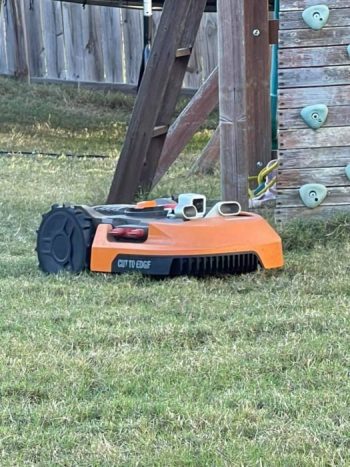WORX: Landroid M Hands-On Review
After using this robotic mower for a full season, my doubts have disappeared.
Since the mid-1990s robotic lawn mowers have been hanging around on the outskirts of mainstream lawn care. Let’s face it, old habits are tough to break – buying a home and mowing the grass with a gas powered lawn mower once a week is part of the American dream, right? Not to mention that the time, labor, and energy-saving idea at the core of robotics was initially bigger than the available tech could support. I was a long term skeptic, until I actually tried one.
In my summer-long test of the WORX Landroid M, I realized that somewhere along the line technology, battery life, and pricing of robotic mowers had converged at a workable point for average users with all types of lawns, wherever they live. That’s great news for busy gardeners who don’t love mowing, and for the environment as we burn less gasoline. Coming up, I’ll share my observations and experience using the Landroid M, but first have a look at the specs for quick reference.
Landroid M Robotic Lawn Mower
- Coverage: .25 acre, or 10,890 square feet
- Mowing Height Range: 1.5 to 3.5 inches
- Maximum Incline: 20 degrees, or 35 percent
- Controlled By: Manually, or Landroid mobile app via WiFi and Bluetooth
- Powered By: 20V, 4.0 Ah WORX Power Share Li-ion battery
- Mowing Time Per Charge: 2 hours
- Recharge Time: 1.5 hours
A Note About Robotic Mowers
Before diving into the Landroid M operational details, it’s important to consider the difference between conventional mowing and robotic mowing. The mowers we’ve used for more than a century are designed for weekly maintenance, during which they remove about ⅓ of the overall height of the grass. To do this, they need a lot of power, both for cutting and for handling the clippings in one of three ways, side discharge, bagging, or mulching. This applies to all conventional mowers, whether they are powered by gasoline, plug-in electricity, or rechargeable batteries.
A robot grass mower, on the other hand, is designed to cut the grass three or more times per week. Doing so only removes the very tips of the grass blades, and the super fine clippings essentially disappear into the lawn without additional treatment. So robot mowers only require a fraction of the power needed for old fashioned mowing.
As a point of comparison, the test area that Landroid M mowed autonomously, powered by a rechargeable 20V tool battery, requires about 16 ounces of gasoline per mowing with my 166 cc push mower, or about 3.25 gallons of gas per season (mowing 26 times). At $3.50 per gallon, the cost of fuel would be $11.38 per year, or $56.90 over five years. At one charge cycle per day for the 26 week mowing season, I calculated that Landroid would use about 14.56 KWh to keep the battery charged (20V x 4.0Ah= 80Wh/day x 182 days= 14,560). My electric coop charges $0.05 per KWh, so the electricity cost per season would be just $0.73, or $3.56 for five years.
Landroid Set Up
I received the Landroid M along with two key accessories that are sold separately: the Landroid Garage, which shields the mower from direct sunlight and precipitation while at its docking station, and the ACS system, which helps the unit identify and avoid obstacles while mowing – more on that later. To get started, I had to download the Landroid app, install the docking station and perimeter wire, and charge the battery.
The best spot for the docking station is a flat area close to an outdoor electrical outlet. It also needs good WiFi reception. I had a perfect spot out back not far from my air conditioner unit and below the home office window. Thanks to favorably flat terrain in the immediate area, setting up home base only took about 5 minutes. I placed it about 10 feet from the ac unit to ensure a long, straight, unobstructed approach. The hardest part was installing the plastic screw anchors into my rocky clay soil. Once the base and garage was assembled and anchored, I attached the power and docked the mower to begin charging.
While the robotic mower charged, I installed the guide wire around the perimeter of the lawn. I laid the wire loosely around the yard at first, then followed up by securing it in place with anchor stakes. The included installation template made it easy to maintain the proper distance from the guide wire to any boundary obstacles like the wall of the house, patio edge and fence. I also made a couple of loops around permanent obstacles in the middle of the lawn – a landscape island bed and the mulch ring around a tree. Guide wire installation took about an hour and a half, and by that time the battery had charged. Time to pair it with the app (with a quick scan of the mower’s QR code) and start mowing.
Mowing with Landroid M
When Landroid mowed my yard, it traveled in a random pattern inside the boundary wire. Often it made long straight runs across the middle of the lawn. When it met the boundary wire, it stopped and redirected. When the ACS system sensed an obstacle that was not excluded with boundary wire, such as a grill, lawn chair, toy, person, or pet, it veered around the obstacle. If not equipped with the ACS system, Landroid still uses the boundary wire, but bumps into items left on the lawn before redirecting. Small obstacles, like pinecones, twigs, and small toys on my lawn did not trigger the ACS, and were in danger of being mowed.
The Landroid app offered plenty of customization to control exactly which days and times the mower operated. These features are handy for those who want to ensure they pick up toys or pet waste prior to mowing. I was more interested to learn what the mower could do on its own. I selected the “auto schedule” feature which allowed the mower to “learn” my lawn and create a custom schedule for maximum efficiency. The first few times it mowed, it operated for 2 hours each time. After 7 days, it had self-adjusted to a twice-daily routine, including two edge-cut cycles each week.
Two mowing features that stood out were the Edge Cut program and the rain sensor. In Edge Cut mode, the robot mower follows the boundary wire around the perimeter of the yard to ensure a crisp edge. It is possible to run an Edge Cut cycle manually, but as I noted earlier, the auto schedule included two Edge cuts per week and that was sufficient. Thanks to built-in rain sensors, Landroid automatically discontinued mowing and returned to the base station whenever rain started. An automatic sprinkler system could cause the same result. When the rain sensor dried out, the mower resumed the mowing cycle where it left off.
My Overall Impression of Landroid M
After a season using Landroid M, I was impressed by several elements. It handled my yard surprisingly well, especially considering the mix of grass types (Bermuda, centipede, and tall fescue) and steep slope in a couple of spots. The brushless motor is both efficient and extremely quiet – I could not hear it operating while I was working in a different part of the yard 75 feet away. I also like that it uses an easy to replace 20V Power Share battery, which should last at least 500 charge cycles before it needs to be replaced.
Landroid M proved to be very reliable week in and week out. I played around with schedule customization options for a few weeks, and ended up going back to the auto-scheduler because I really didn’t see a need for improvement. I still had to touch up the edges with a string trimmer every couple of weeks, and ran my hard edger down the driveway and patio edges about once a month to keep them nice and tight. From a maintenance standpoint, I changed the three razor blades on the cutting head monthly. The labor savings were tremendous, to the point where I simply stopped thinking about mowing and had to set a reminder just to check up on the mower in the app once a week, and to change the blades.
Weighing the economics and environmental impact of using a single 20V battery over its five year or longer life span, versus burning 15 to 20 gallons of gasoline in the same amount of time, the battery option seems to offer cleaner potential as power generation moves toward renewables. I had a great experience using the Landroid M. It answered my doubts beyond my expectations, and I think it could be a great investment for anyone who is interested in reducing their summer chore list or their carbon footprint.
Watch Landroid being installed below!
View this post on Instagram

